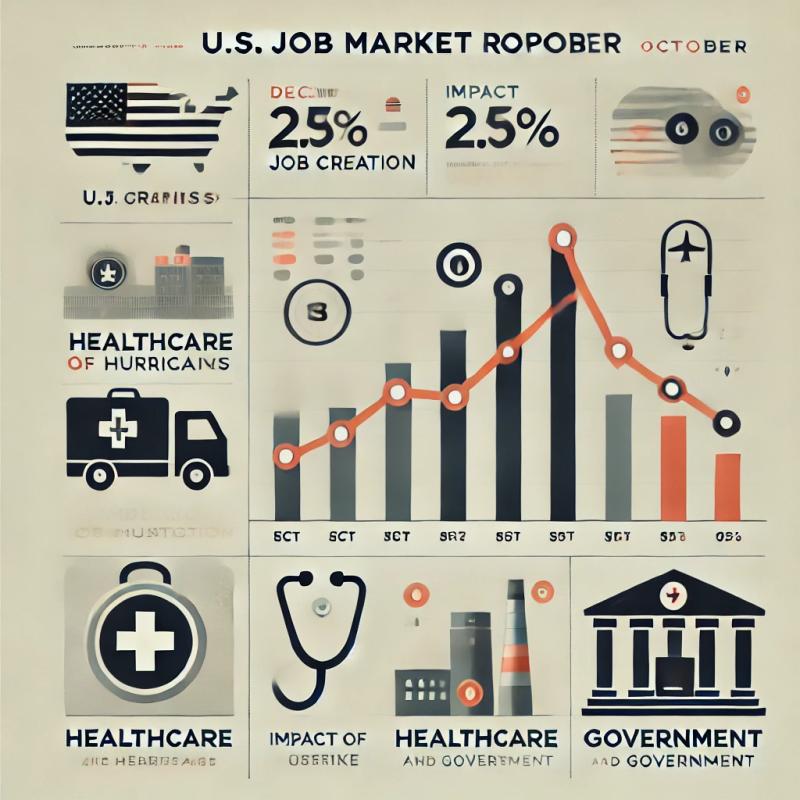October Job Growth Slows to 12,000 Amid Hurricanes and Strikes, Raising Concerns Ahead of Election

- agastya9
- 04 Nov 2024 06:58 AM
- Inflation, JobGrowth
In October, the U.S. economy added just 12,000 jobs, marking the slowest job growth since late 2020, as hurricanes and labor strikes affected employment. The nonfarm payrolls increase fell sharply from September and was well below the Dow Jones estimate of 100,000, according to the Bureau of Labor Statistics (BLS). This is the smallest monthly gain since December 2020.
The unemployment rate held steady at 4.1%, matching expectations. A broader measure of unemployment, which includes discouraged workers and those working part-time for economic reasons, remained unchanged at 7.7%.
The BLS attributed a significant part of the slowdown to the Boeing strike, which subtracted approximately 44,000 jobs from the manufacturing sector. Overall, manufacturing lost 46,000 jobs in October. Additionally, hurricanes Helene and Milton impacted job creation, though the BLS noted it was difficult to quantify the exact effect.
The BLS also highlighted that the survey response rate for October’s establishment survey, which determines the headline nonfarm payrolls figure, was “well below average” — the lowest in more than 30 years. This was true for both areas hit by the storms and those outside the affected zones.
Average hourly earnings increased by 0.4% for the month, slightly above estimates, with a 4% annual gain. The average workweek remained stable at 34.3 hours.
Despite the weak jobs data, financial markets reacted positively, with stock market futures pointing to a strong open, while Treasury yields fell. The jobs report, coupled with wage growth in line with expectations, reinforced market expectations for another interest rate cut from the Federal Reserve next week.
Economist Cory Stahle from the Indeed Hiring Lab noted that October’s report showed a fragile labor market, disrupted by weather and labor strikes, but emphasized that these impacts were likely temporary and not indicative of a collapse.
The release of the report comes just days before the presidential election, where the economy is a central issue in the contest between Democrat Kamala Harris and Republican Donald Trump, who are neck and neck in the polls. Chief economist Lisa Sturtevant from Bright MLS said the weak jobs numbers cast uncertainty over the election.
The October report also revised downward the job gains from previous months. August's job growth was lowered to 78,000, while September’s initial estimate was revised down to 223,000. In total, the net revisions cut previously reported job creation by 112,000.
Health care and government led job creation, adding 52,000 and 40,000 jobs, respectively. However, several sectors reported losses. In addition to the hit to manufacturing, temporary help services saw a decline of 49,000 jobs. This category, often considered a proxy for job market strength, has dropped by 577,000 since March 2022.
Other sectors, including leisure and hospitality, retail trade, and transportation and warehousing, also experienced job declines. Leisure and hospitality, a key driver of post-pandemic recovery, shed 4,000 jobs in October.
The household survey, which is used to calculate the unemployment rate, showed even weaker hiring numbers. The survey revealed 368,000 fewer people reporting employment, with the labor force shrinking by 220,000. Full-time employment fell by 164,000, while part-time workers dropped by 227,000.
October was a challenging month for the labor market, with hurricanes hitting states like Florida and North Carolina and the Boeing strike affecting what had been a strong but slowing employment sector. Despite these setbacks, there are signs that the Boeing strike may soon be resolved.
Prior to October, job creation had averaged around 200,000 jobs per month in 2024, lower than last year’s pace by 60,000, but still reflecting a solid hiring environment. However, recent cracks in the labor market have raised concerns at the Federal Reserve about the potential impact of elevated interest rates on employment and economic expansion.
In response, the Federal Reserve took the unusual step in September of lowering its short-term interest rate by half a percentage point. Financial markets are expecting the Fed to continue with quarter-point cuts at its two remaining meetings this year, with the next rate decision set for next Thursday.










































